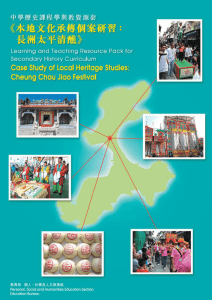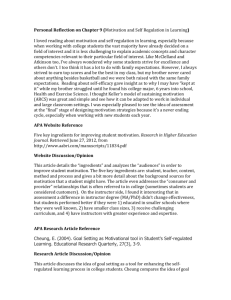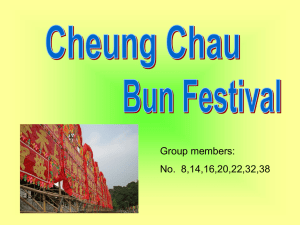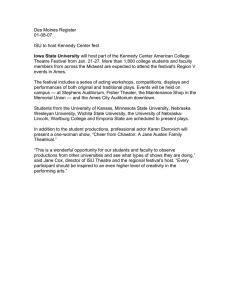Dajiao 2 2 Exemplars Eng
advertisement
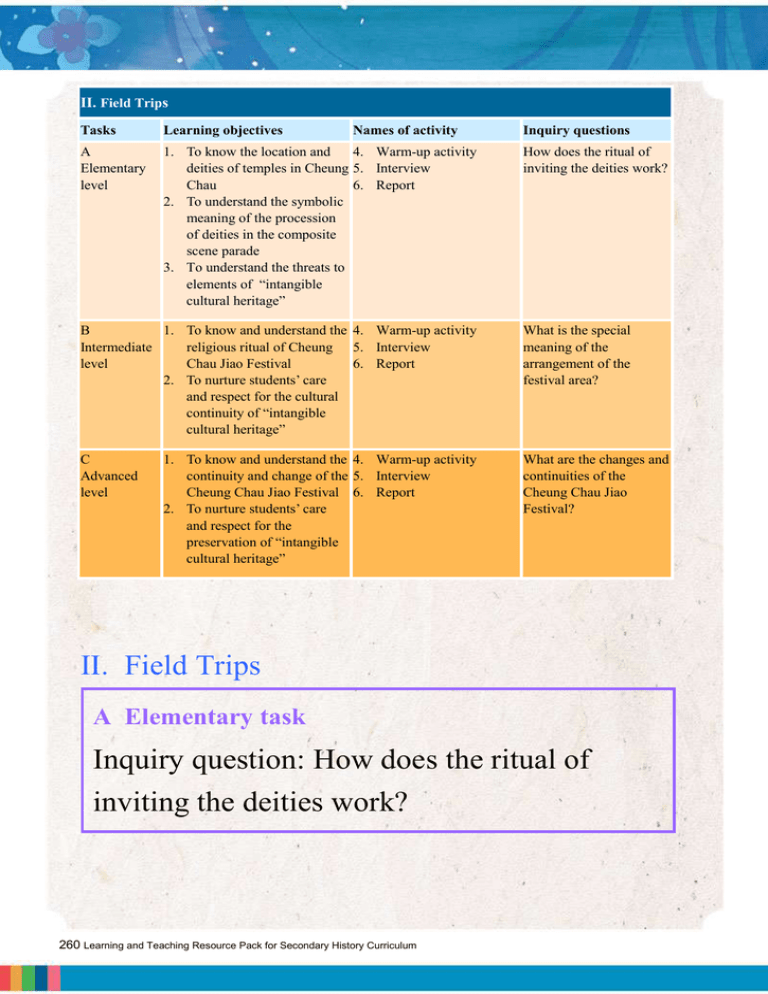
II. Field Trips Tasks Learning objectives Names of activity A Elementary level 1. To know the location and 4. Warm-up activity deities of temples in Cheung 5. Interview Chau 6. Report 2. To understand the symbolic meaning of the procession of deities in the composite scene parade 3. To understand the threats to elements of “intangible cultural heritage” Inquiry questions How does the ritual of inviting the deities work? B 1. To know and understand the 4. Warm-up activity Intermediate religious ritual of Cheung 5. Interview level Chau Jiao Festival 6. Report 2. To nurture students’ care and respect for the cultural continuity of “intangible cultural heritage” What is the special meaning of the arrangement of the festival area? C Advanced level What are the changes and continuities of the Cheung Chau Jiao Festival? 1. To know and understand the 4. Warm-up activity continuity and change of the 5. Interview Cheung Chau Jiao Festival 6. Report 2. To nurture students’ care and respect for the preservation of “intangible cultural heritage” II. Field Trips A Elementary task Inquiry question: How does the ritual of inviting the deities work? 260 Learning and Teaching Resource Pack for Secondary History Curriculum A4 Warm-up activity Checkpoints on the route of inviting the deities Suggested date of the field trip: The 5th day of the 4th lunar calendar month Suggested time of the field trip: Arrival at Pak Tai Temple before 9 a.m. Activity 1 Pre-trip exercise 1. Finish this exercise before setting out for the field trip. Link up the temples in Cheung Chau with their relevant community groups and/or events. Relationships with local community groups / relevant historical events Checkpoint 1 A It is located in Pak She Street in which many Huizhou and Chaozhou people reside. Established in 1783 (i.e. the 18th year of Emperor Qianlong’s reign), it has a history of over 200 years. It was listed as Grade I historical building by the Antiquities Advisory Committee. Pak She Tin Hau Temple 2 B It is located in Pak She Street in which many Huizhou and Chaozhou people reside. The oldest existing historical relic is a copper bell cast in 1767 (i.e. the 32nd year of Emperor Qianlong’s reign). The temple underwent major renovations in 1889 (i.e. the 15th year of Emperor Guangxu’s reign) and 1968. Pak Tai Temple (i.e.Yuk Hui Temple) 3 Tai Shek Hau Tin Hau Temple C It is a colourful temple in the form of a pavilion. It houses an 8-foot statue of Guandi (i.e. Kwan Kung) carved out from an entire camphor tree. On the couplets at the temple’s entrance are written to describe the personality of this historical figure of the “Three Kingdoms” era: “Aspired to leave a legacy in history, brilliant achievements in Shu Han he made. Vowed to strict justice and saintly loyalty, unfailing brotherhood and bond he displayed.” Case Study of Local Heritage Studies: Cheung Chau Jiao Festival • Exemplars of Learning and Teaching Activities 261 Relationships with local community groups / relevant historical events Checkpoint 4 D There are two horizontal inscribed boards showing the words “Tongzhi” and “Daoguang”. It can be inferred that the temple was established before the middle of the Qing Dynasty. The temple underwent renovation in 1898, and there is a plaque stating the history of renovating the temple. Hung Shing Temple 5 E It is located at Tai Shek Hau where many Cantonese people live. Tin Hau is set at the middle chamber of this temple for worshipping. The shrine on the right hand side is for worshipping the “Fly-back Heavenly General” which is unique in Hong Kong. Nam Tam Tin Hau Temple 6 F It is located at the junction of Tai Sun Street and Chung Hing Street, facing the Cheung Chau Wan where many Guanyin and Hua Tuo statues are placed. On 18 December 2009, the temple was listed as Grade 2 historical building. In 1814 (i.e. the 18th year of Emperor Jiaqing’s reign) fishermen of the Island built this temple by pooling together some fund. It was at first managed by the local residents, but later it was put under the Chinese Temples Committee for management. G The origin of this temple cannot be traced any more. According to some hear-say accounts, though, it has a century-old history. The current appearance of the temple was made during the renovation work in 1968. The horizontal inscribed tablet shows the words which mean “The Palace of Tin Hau”, while the couplets are inscribed as: “Her holy virtues last for numerous centuries, and her sacred light shines on every nation. Her motherly bearing extends to eternity, and her godly blessings reach all directions.” Kwan Kung Pavilion 7 Cheung Chau Shui Yuet Temple 262 Learning and Teaching Resource Pack for Secondary History Curriculum Relationships with local community groups / relevant historical events Checkpoint 8 It is located at Sai Wan of Cheung Chau, between which and the Cheung Chau Wan the fishermen of Cheung Chau reside. The temple has a 200year long history. There is a copper bell cast during the reign of Emperor Qianlong in the temple, and a little pavilion behind it. On the Birthday of Tin Hau every year, residents come to present incense to Tin Hau. It is listed as Grade III historical building. H Sai Wan Tin Hau Temple My answers: Local temples 1 2 3 4 5 6 7 8 Relationships with the local community / relevant events e.g. B A E F G C D H Case Study of Local Heritage Studies: Cheung Chau Jiao Festival • Exemplars of Learning and Teaching Activities 263 Activity 2 Read the following map carefully concerning the route of inviting the deities. Where are the starting point and the destination? Pak Tai Temple Activity 3: Photo-taking Refer to Guideline on Field Trip, ask students to take photos of inviting deities at Checkpoints 1 and 2. 264 Learning and Teaching Resource Pack for Secondary History Curriculum A5 Interview 1. Choose a target (either a worshipper in the temple or a tourist) to conduct the interview. The objective of the interview is to analyse the interviewee’s level of understanding of the deity inviting rituals in the Cheung Chau Jiao Festival. Suggested questions and answers: (1) Which religious ritual of the Cheung Chau Jiao Festival is being held now? A. Running the noon offering B. Inviting the deities C. The first composite-scene parade D. Procession of the deities and the figures (2) Who form the team that invites Xuantian Shangdi (i.e. Pak Tai) and Tin Hau? A. The chairmen and vice chairmen of the Jiao Festival Organizing Committee B. The Taoist ritual masters C. The festival helpers bringing gongs and drums D. All of the above (3) According to your observation, which deity has the highest status in the deity-inviting ritual? Why? A. Xuantian Shangdi (i.e. Pak Tai) of Tai Ping Shan B. Hung Shing of Cheung Chau C. Tin Hau of Sai Wan D. Tin Hau of Chung Hing Street, Cheung Chau E. Tin Hau of Nam Tam, Cheung Chau F. Tin Hau of Pak She, Cheung Chau G. Guanyin (i.e. Goddess of Mercy) of Shui Yuet Temple, Cheung Chau H. Guandi (i.e. Kwan Kung) of Kwan Kung Pavilion, Cheung Chau I. Pak Tai of Yuk Hui Temple (i.e. Pak Tai Temple), Cheung Chau (Reason: The Cheung Chau Jiao Festival takes Xuantian Shangdi (i.e. Pak Tai) of Yuk Hui Temple (i.e. Pak Tai Temple) as its leading deity. Pak Tai is the deity commonly worshipped by residents of the island.) Case Study of Local Heritage Studies: Cheung Chau Jiao Festival • Exemplars of Learning and Teaching Activities 265 (4) Which of the following is the area of Pak Tai’s procession during the process of inviting the deities? A. Offshore area from Cheung Chau Wan to Sai Wan B. Hing Lung Street and Tai Sun Street C. Chung Hing Street and Pak She Street D. San Hing Street and Pak She Street (5) Which of the following ethnic groups in Cheung Chau participate the most actively in the Cheung Chau Jiao Festival? A. Huizhou people B. fishermen of Cheung Chau C. Cantonese people living in Cheung Chau D. Other Hong Kong residents visiting Cheung Chau 2. Record the interview results in the table below. No. of interviewees Q. 1 Option B Q. 2 Option D Q. 3 Option I Q. 4 Option D Q. 5 Option A No. of interviewees who provide reasonable explanations: 3. Analyse the interview results: Based on the above interview results, analyse the interviewees’ level of understanding of the Cheung Chau Jiao Festival. Statistical analysis: ** Most/Few/Very few interviewees understand the process of inviting the deities during the Jiao Festival. Observation results: Based on interviewees’ facial expressions, responses, attitudes, etc. 266 Learning and Teaching Resource Pack for Secondary History Curriculum A6 Report 1. The Checkpoint you visited is: (put a tick( ) in the appropriate box(es)) Pak She Tin Hau Temple Pak Tai Temple (i.e. Yuk Hui Temple) Tai Shek Hau Tin Hau Temple Cheung Chau Hung Shing Temple Nam Tam Tin Hau Temple Kwan Kung Pavilion Cheung Chau Shui Yuet Temple Sai Wan Tin Hau Temple 2. Which temple in Cheung Chau impresses you the most? Why? Free answer. 3. Record some unforgettable people and events during your field trip with pictures or words. Free answer. 4. According to your interview results in Task A5 regarding interviewee’s understanding of the Jiao Festival, what measures would you propose to increase the general public’s understanding of the Cheung Chau Jiao Festival? Free answer. Case Study of Local Heritage Studies: Cheung Chau Jiao Festival • Exemplars of Learning and Teaching Activities 267 B Intermediate task Inquiry question: What is the special meaning of the arrangement of the festival area? B4 Warm-up activity Checkpoints of bamboo poles, noon offering and festival area Suggested date of the field trip: The 7th day of the 4th lunar calendar month Suggested time of the field trip: During daytime Activity 1 Pre-trip study Before setting out for the field trip, fill in the following table the sequence and the respective venues of the Jiao Festival rituals. Ritual Content Venue Inviting the deities Inviting various deities on the island to watch the daijiao Drawing the eyes of the deities’ statues and starting the worship The ritual of presenting offerings to the deities from the five directions Presenting gifts to and driving off the spirits wandering on the sea Driving off the spirits of the deceased wandering in the mountain Inviting the Jade Emperor and various deities to come forth The deities parade through and cleanse the streets under the leadership of the Taoist ritual masters Under the leadership of the Taoist ritual masters, local residents present gifts to the wandering spirits Presenting animal meat to the deities so as to feed them and pray for peace in the forthcoming year All residents of the island can start eating meat. During the jiao period, all residents of Cheung Chau have to fast. Distributing the lucky buns on the bun towers to all people To thank the deities by performing worshipping plays Deities’ altar 2 Deities’ altar 3 Deities’ altar 5 Offshore area of Sai Wan 7 From the foothill to the festival area Jiao shed 6 Inside the festival area 8 Offshore area near Pak Tai Temple Playground Beneath the three great gods’ altar The whole island The whole island 9 The opera shed 13 The opera shed Every day To repent in front of the deities and pray for forgiveness for their sins. Venues of erecting bamboo poles in the festival area, and the altars. Previously in the Lucky Bun Shed, and now in the Pak Tai Temple Playground. Every day Dedication ceremony Running the noon offering Feeding the water ghosts Presenting offering to the Mountain God Inviting the deities Composite-scene parade Feeding the Ghost King Giving thanks to the deities Breaking the fast Fasting Distributing the lucky buns Performing devotional Cantonese operas Running the offerings and repentances The race of snatching buns on the bun towers The race of snatching buns on the bun towers 268 Learning and Teaching Resource Pack for Secondary History Curriculum Sequence 4 11 12 1 10 Activity 2 If the arrangement of the festival area is found to be different from the layout below, the following layout plan can be modified. Then, choose 3 spots from (1) to (6) below for photo-shooting, and paste the photos in the space below. Also, point out which category of intangible cultural heritage each of these places belongs to. (1) Pak Tai Temple (2) The deities’ altar (4) The jiao shed (i.e. the Taoist ritual masters’ shed) (3) The opera shed (5) The 3 big bun towers (6) Small bun towers (Pak She Street) Case Study of Local Heritage Studies: Cheung Chau Jiao Festival • Exemplars of Learning and Teaching Activities 269 Photo Photo Photo Description Description Description 270 Learning and Teaching Resource Pack for Secondary History Curriculum Activity 3 1. Label the locations of the 9 bamboo poles in the street map of Cheung Chau below: (For answers, refer to p.186) 2. Analyse the location and the symbolic meaning of the locations of the bamboo poles. Suggested answer: According to the map above, on the day before the Jiao Festival starts, 9 bamboo poles are erected in the festival area, and they are scattered to different locations of the old town area of Cheung Chau. This is exactly the residing and living area of the Cheung Chau residents who help to organize the Jiao Festival. It also symbolizes the area of cleansing and blessing. As regards Sai Wan where the boat people live, the Chinese cemetery in Nam Shan, the church, the residences of foreigners, the Christian cemetery of Pak Shan and the newly built villages of the Tanka boat people, these are not included in the festival area. This reflects that the cleansed and blessed area of the Cheung Chau Jiao Festival does not cover the whole island. Case Study of Local Heritage Studies: Cheung Chau Jiao Festival • Exemplars of Learning and Teaching Activities 271 B5 Interview 1. Select a target group (either the worshippers in the temples or the residents of Cheung Chau) to conduct interviews. The objective is to analyse the interviewee’s level of understanding of the festival area arrangements. Suggested questions and answers: (1) Which place of the festival area is for worshipping the Ghost King, the Mountain God and Earth God? The three deities’ great altar (2) Where is the noon offering run? A. The opera shed B. The deities’ altar C. The bun towers shed D. The plaza (3) What is the main objective of running the noon offering? A. To ensure good fortune for every year to come B. To relieve disasters and calamities C. To thank the deities for their grace and blessings D. To destroy the old and establish the new (4) Why is an opera shed set up in the festival area? A. To raise the jolly atmosphere B. To cleanse the community C. To perform devotional Cantonese operas to entertain the deities D. To remove the old and embrace the new (5) What is the meaning of erecting bamboo poles in the festival area? A. To indicate the location of the race of snatching buns on the bun towers B. To reflect the importance of running the noon offering C. To mark the location of feeding the ghosts D. To delineate the area of cleansing and blessing 272 Learning and Teaching Resource Pack for Secondary History Curriculum (6) How many locations of bamboo poles can you name? - Outside the Yuk Hui Temple (i.e. Pak Tai Temple) - At the junction outside Pak She Tin Hau Temple - At the junction of San Hing Street and Kwok Man Road - Praya Road - In front of Hung Shing Temple - Next to Tai Shek Hau Tin Hau Temple - At the the junction of Tai Shek Hau Road and Cheung Tsun Road - At the roadside of Fook Tak Temple - I’Tsz (7-8) Based on the three places in the festival area you have chosen in Task B4, design two interview questions. (7) Interview question 1: _____________________________________________________ (8) Interview question 2: _____________________________________________________ 2. Record the interview results in the table below. No. of Answered interviewees Q.1 correctly Q.2 Option B Q.3 Option B Q.4 Option C Q.5 Option D Q.6 Q.7 Q.8 3. Analyse the interview results: Based on the above interview results, analyse the interviewees’ level of understanding of the Cheung Chau Jiao Festival. Statistical analysis: ** Most/Few/Very few interviewees understand the meaning of erecting bamboo poles, running the noon offering and the arrangement of the festival area. Observation results: Based on interviewees’ facial expressions, responses, attitudes, etc. Case Study of Local Heritage Studies: Cheung Chau Jiao Festival • Exemplars of Learning and Teaching Activities 273 B6 Report (Conservation of the Cultural Heritage of the Cheung Chau Jiao Festival) 1. Based on the above interview results, analyse the interviewees’ level of understanding of the Cheung Chau Jiao Festival. Statistical analysis: ** Most/Few/Very few interviewees understand the meaning of the arrangement of the festival area. Observation results: Based on interviewees’ facial expressions, responses, attitudes, etc. 2. Based on the last question, what proposals would you make to strengthen the conservation of this intangible cultural heritage and enable more people to understand the origin, development and meaning of the Cheung Chau Jiao Festival? Free answer. 3. Suppose you were a docent in charge of introducing the Cheung Chau Jiao Festival. Draft a set of behavioural rules for tourists that inform them how they may help to preserve the intangible cultural heritage of Cheung Chau. Suggested answer: 1. Find out and understand the origin and meaning of the Cheung Chau Jiao Festival. 2. Respect the religious rituals and do not trespass into the altar area. 3. Do not block the passage during the lion dance parade. 4. Respect the fasting tradition of the local residents and do not eat meat during the festival. 5. Cherish the paper effigies and keep your hands off them. 6. Keep silent when watching the devotional Cantonese opera. 7. Do not obstruct any ritual when taking photographs. 8. Any other reasonable answer. 274 Learning and Teaching Resource Pack for Secondary History Curriculum C Advanced task Inquiry question: What are the changes and continuities of the Cheung Chau Jiao Festival? C4 Warm-up activity Checkpoints along the route of the composite-scene parade Suggested date of field trip: The 8th day of the 4th lunar calendar month Suggested time of field trip: Arrive at Cheung Chau before 9 a.m. Activity 1 1. Interviewees with whom appointments must be made in advance: (1) Street associations or sports associations (for gathering information on the production of the colour floats) (2) Paper effigy masters who work for the Cheung Chau Jiao Festival (3) Members and helpers of the Cheung Chau Jiao Festival Organizing Committee 2. Pre-trip study Finish the following exercise before setting out for the field trip to familiarize yourself with the parade route. Read the routes of the second composite-scene parades in 1977 and 2012 carefully, and answer the following questions. Case Study of Local Heritage Studies: Cheung Chau Jiao Festival • Exemplars of Learning and Teaching Activities 275 The parade route of 1977 The parade route of 2012 1 Pak Tai Temple Playground 1 Pak Tai Temple Playground 2 Pak She Street 2 Pak She Street 3 San Hing Street 3 San Hing Street 4 Praya Road 4 Praya Road 5 Shing Cheong Lane 5 Shing Cheong Lane 6 Tai Sun Street 6 Tai Sun Street 7 Chung Hing Street 7 Chung Hing Street 8 Tai Tsoi Yuen Road 8 Tai Tsoi Yuen Road 9 Tai San Back Street 9 Tai San Back Street 10 Hing Lung Back Street 10 Hing Lung Main Street 11 Tung Wan Road 11 San Hing Street 12 Cheung Chau Beach Road 12 Pak She Street 13 Kwok Man Road 13 Pak Tai Temple Playground 14 Pak She Street 15 Pak Tai Temple Playground Suggested answer provided: a. Which checkpoint is the most important along the parade route? Why? The Pak Tai Temple Playground is the most important because it is both the starting point and the destination. b. Which places are no longer on the parade route? Tung Wan Road, Cheung Chau Beach Road and Kwok Man Road. c. At which checkpoint would you stay to watch the second composite-scene parade? Why? Pak She Street or San Hing Street, because the parade team passes through these places for two times. 276 Learning and Teaching Resource Pack for Secondary History Curriculum Activity 2 Observation of focal points: Changes and continuities Having visited all checkpoints, now record all items of intangible cultural heritage you observed in the area below. The checkpoint that I have visited is: (put a tick( ) in the appropriate box(es).) Pak Tai Temple Playground Pak She Street San Hing Street Praya Road Shing Cheong Lane Tai Sun Street Chung Hing Street Tai Tsoi Yuen Road Hing Lung Street San Hing Street What threats do you think the above intangible cultural heritage items are now facing? Why? Activity 3: Photo-taking activity Take photographs during the second composite-scene parade. Case Study of Local Heritage Studies: Cheung Chau Jiao Festival • Exemplars of Learning and Teaching Activities 277 C5 Interview During the field trip, interview (1) the members of the street / kai fong associations or sports associations on the production of the colour floats, (2) the members of the Jiao Festival Organizing Committee on the preparation work of the Jiao Festival, (3) the shop-keepers on the sales of products, or (4) the Cheung Chau residents on their views about the bun tower scrambling race. The objective is to figure out the changes and continuities in the Jiao Festival activities in the last 20 years. 1. Design some interview questions based on the following categories: Interview questions The preparation of the Jiao Festival The designated dates for the Jiao Festival The second composite-scene parade The race of snatching buns on the bun towers Economic activities (e.g. tourists and shops, etc.) Cheung Chau residents’ views about the Jiao Festival Participation of different ethnic groups 1. e.g.: How do the residents of Cheung Chau take part in the preparation work of the Cheung Chau Jiao Festival? 2. e.g.: How were the dates of the Jiao Festival decided in the past? 3. e.g.: How different are the second composite-scene parade and the production of colour floats nowadays from those in the past? 4. e.g.: How did the form of the race of snatching buns on the bun towers change? 5. e.g.: What products/food are the most popular? 6. e.g. According to your opinions, what are the benefits of inscribing the Cheung Chau Jiao Festival onto the National List of Intangible Cultural Heritage? 7. e.g.: What do you think are the social functions of the Cheung Chau Jiao Festival to the local community of Cheung Chau? 278 Learning and Teaching Resource Pack for Secondary History Curriculum 2. After the interview, tidy up the following table of changes and continuities in various aspects of the Cheung Chau Jiao Festival. Changes and continuities Changes The preparation of the Jiao Festival Continuities Changes Content of activities of the Jiao Festival Continuities The second composite-scene parade The race of snatching buns on the bun towers Economic activities (e.g. tourists and shops, etc.) Cheung Chau residents’ views about the Jiao Festival Participation of different ethnic groups Changes Continuities Changes Continuities Changes Continuities Changes Continuities Changes Continuities Case Study of Local Heritage Studies: Cheung Chau Jiao Festival • Exemplars of Learning and Teaching Activities 279 C6 Report Combining the interview results of Tasks C5 and C6, complete the table below about the changes and continuities in various aspects of the Cheung Chau Jiao Festival and answer the following questions. Suggested answers: Cheung Chau Jiao Festival in the past The Jiao Festival Organizing Committee changes continuities Selections and the selection of festival dates changes continuities The second compositescene parade changes continuities Cheung Chau Jiao Festival nowadays Although the restrictions were relaxed after 1960 and some Cantonese people take part in the committee, the chairmen and vice chairmen must still be chosen from members of the Huizhou and Chaozhou Prefecture Association. The Jiao Festival Organizing Committee has relaxed the restrictions on membership so as to let any interested resident take part in the Jiao Festival matters. Since 2001, the second composite-scene In the past, the selection of chairmen and parade has been fixed on the 8th day of the vice chairmen and the festival dates were 4th lunar calendar month for the decided by casting divination blocks in Pak convenience of tourists in watching the Tai Temple in the early 1st month of the 1st abundant events of the Cheung Chau Jiao lunar calendar month. Festival. It is no longer necessary to cast divination blocks. Before the 1960s, only members of the Huizhou and Chaozhou Prefecture Association could become members of the Jiao Festival Organizing Committee. Although the dates of the Jiao Festival are already fixed and need not be decided by rituals in front of Pak Tai every year, the selection of the chairmen and vice chairmen are still decided by casting kidney-shaped divination blocks in front of Pak Tai. The religious features have been gradually weakened, while the parade team becomes longer, with flute-playing children’s teams, folk dance teams and brass bands. This increases the entertainment value of the festival. Same as the tradition, the procession team is led by the Taoist ritual masters. The deities paraded throughout the festival area to cleanse the localities. The processions in the past were purely religious, featuring that the Cheung Chau residents bear the deities’ shrines while parading through the major streets in Cheung Chau. ˙ ˙Residents built the bun tower with bamboo sticks. changes ˙All the buns on the tower were white steamed bread. ˙After the Jiao rituals, residents rushed to Bun tower climb the bun towers to snatch the buns, continuities Religious rituals changes continuities ˙ The race of snatching buns on the bun towers was restored in 2005. The bun tower is built with steel rack, and the buns are made of plastic. Safety measures are adopted, and there are races for the selection of good athletes. Bakeries sell not only lucky buns, but also buns stuffed with fillings to earn more profits. Taoist ritual masters bless the lucky buns while the Cheung Chau residents snatch the buns and take them home for eating together with their families after the end of the fasting period and the Jiao Festival. This is done to guarantee communal safety Many Cheung Chau residents observed the three-day fasting tradition. The fasting tradition has been relaxed. While the breaking of the fast would take place after the Great Offering at 12:00 noon in the past, the restaurants on the island have started to sell meat dishes right after the second composite-scene parades in recent years. The traditional jiao rituals of the Hailufeng localities are retained. 280 Learning and Teaching Resource Pack for Secondary History Curriculum 2. Why are there changes in the tradition? What are the advantages and disadvantages of such changes? Reasons for the changes in the tradition e.g.: The dates of the festival being no longer decided by casting divination blocks in the Pak Tai Temple, this was done to coordinate with the general holidays and for visitors’ convenience in visiting the festival in Cheung Chau. The Organizing Committee decided to change the tradition, increase the number of parade teams and strengthen the promotion so as to make the Cheung Chau Jiao Festival the focal point of tourists. In order to promote tourism and ensure hygiene and safety, the white steamed buns for the race of snatching buns on the bun towers are replaced by plastic buns. The advantages and disadvantages of the changes e.g.: Advantage – The festival becomes a focal point of cultural tourism; more people get to know this festival. Disadvantage – In order to coordinate with the development of the tourism industry, the religious elements of the traditional religious activities are compromised and neglected. 3. Effective means of conservation Free answer Case Study of Local Heritage Studies: Cheung Chau Jiao Festival • Exemplars of Learning and Teaching Activities 281
